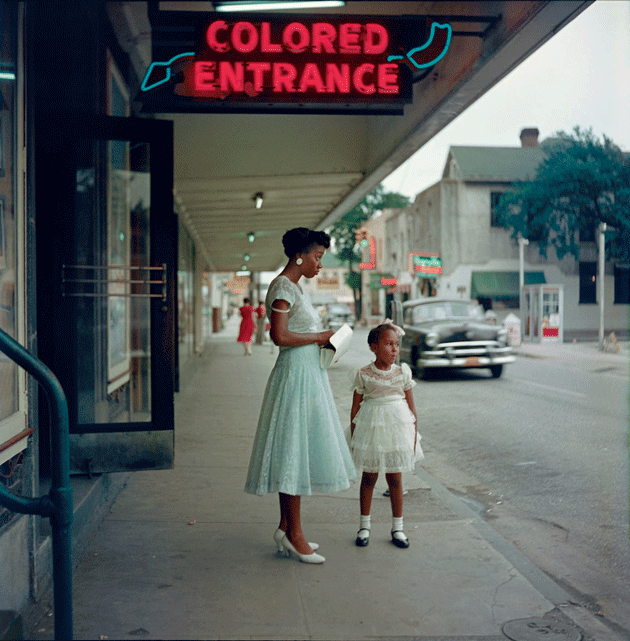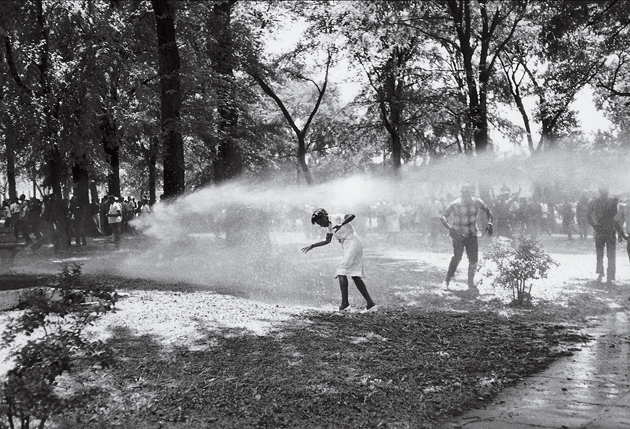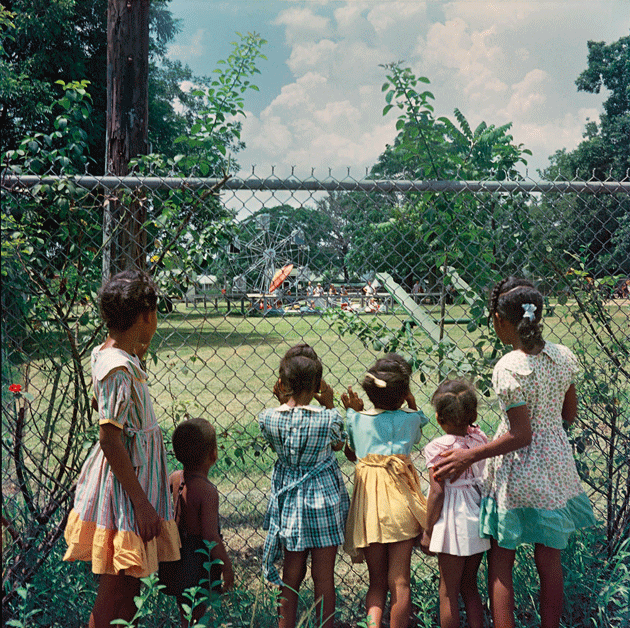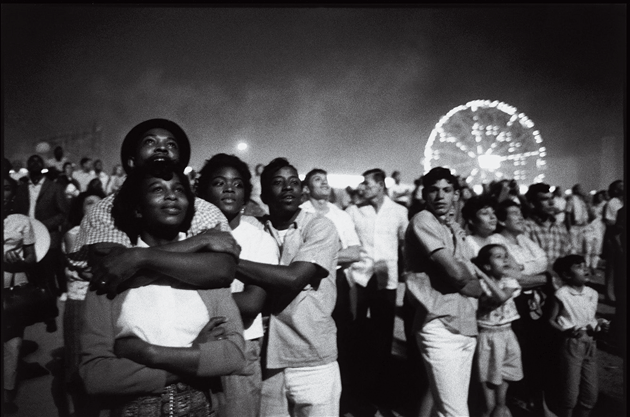When I was a kid, in the early Sixties, my mother and father meticulously prepared our car for holiday journeys from our home in Washington, D.C., to my birthplace in Columbia, South Carolina. They packed coolers filled with sodas, deviled eggs, chicken wings, sandwiches of all varieties, cookies, and candy. I thought of this at the time as an effort to make the eight-hour ride into a party for me and my older brother and younger sister. Only later did I learn that their preparations stemmed from fear. Having fled the Jim Crow South in the Fifties, my parents were seeking to limit our contact with filling stations, restaurants, motels, and other public accommodations along the way, where their children might be snarled at by white cashiers and attendants. As I matured, I saw that once we crossed the Potomac River and ventured into Virginia, we encountered a terrain that filled my parents with dread.
My father was particularly burdened by the drive. He became noticeably nervous at the sight of police officers. Over the years several of them pulled him over. They did not charge him with any infraction. Rather, they stopped him seemingly out of curiosity and a desire to test his willingness to accept the etiquette of white supremacy. Their colloquies went something like this:
“That’s a nice car you’re driving, boy.”
“Thank you, officer. Have I done something wrong?”
“Not from what I can see just yet. I notice you’ve got out-of-state plates. You know, we do things different down here. You do know that?”
“Yes, sir.”
“Boy, you do know that, right?”
“Yassuh.”
“Okay. You’re free to go.”
The drive took us into territory that featured signs distinguishing “colored women” from “white ladies,” signs indicating whether a business served blacks, signs designating which toilets or water fountains or entrances African Americans were permitted to use. In those days it was legal throughout the Deep South for privately owned places of public accommodation to exclude people on the basis of race — colored not allowed — or to discriminate against them in other ways — colored served only in the rear. This reality prompted Victor H. Green, of Harlem, to publish The Negro Motorist Green Book, a guide to establishments throughout the United States that served black travelers. He understood the anxiety that beset African Americans as they sought to obtain elementary decencies on the nation’s highways.
The Civil Rights Act of 1964, which became law fifty years ago this summer, decisively altered this dismal situation. The origins of the act reside outside the lived experience of most Americans, which makes remembering and assessing this benchmark all the more important. Americans should know why there was a need for such a law, and we should understand both the constitutional predicate on which it is grounded and the reason why one of its seemingly least controversial features — the provision banning racial discrimination in privately owned places of public accommodation — was once heavily contested. We should also recognize echoes of the fights from ’64 in current disputes over affirmative action, health-care expansion, and a host of other political issues.
Prior to the Sixties, white supremacists often expressed themselves candidly. When Senator Benjamin “Pitchfork Ben” Tillman criticized President Theodore Roosevelt in 1901 for inviting Booker T. Washington to dine at the White House, he remarked, plainly, “Entertaining that nigger will necessitate our killing a thousand niggers in the South before they will learn their place again.” “White Supremacy will be maintained in our primaries,” South Carolina governor Olin Johnston declared frankly at a special legislative session he called in 1944 to respond to a recent U.S. Supreme Court ruling that invalidated the barring of black people from voting in Democratic Party primaries. “Let the chips fall where they may!”
By 1964, however, outright expressions of racist sentiment were increasingly seen as ugly. So white supremacists had to find a politically palatable way to do what “nigger” had formerly done. They developed a vocabulary of obstruction that remains very much with us today, a lexicon that relies strongly on claims to liberty (as opposed to equality) and states’ rights (as opposed to federal regulation) and freedom of association (as opposed to inclusiveness). Opponents of the Civil Rights Act warned that its implementation would further empower an already tyrannical federal government, just as enemies of the Affordable Care Act warn us today. They depicted it as snatching freedom from white business owners in order to propitiate lawless blacks by securing them preferential treatment — the precursor to recent arguments about “reverse discrimination.” Segregationists asserted that the civil rights movement was part of a global communist conspiracy, just as many Americans now say they fear a socialist takeover of their government.
It’s clear that conditions have changed dramatically over the past half century. In 1964 there had never been a black Cabinet official, a black Supreme Court justice, or a black Fortune 500 CEO. But even though we are living in the second term of a black president, American politics remains divided along the same racial lines that fragmented debate over the Civil Rights Act.
“I guess it is easy for those who have never felt the stinging darts of segregation to say ‘Wait,’ ” Martin Luther King Jr. wrote from Birmingham City Jail in April 1963. King, who had been arrested along with other demonstrators, was responding to criticism by white Alabama clergymen who complained that his protests in the streets against racial mistreatment were “untimely.” “But when you have seen vicious mobs lynch your mothers and fathers at will and drown your sisters and brothers at whim,” King continued;
when you suddenly find your tongue twisted and your speech stammering as you seek to explain to your six-year-old daughter why she can’t go to the public amusement park that has just been advertised on television . . . ; when you take a cross-country drive and find it necessary to sleep night after night in the uncomfortable corners of your automobile because no motel will accept you . . . ; when you are harried by day and haunted by night by the fact that you are a Negro, living constantly at tiptoe stance, never quite knowing what to expect next, and plagued with inner fears and outer resentments; when you are forever fighting a degenerating sense of “nobodiness”; — then you will understand why we find it difficult to wait.
African Americans in the Jim Crow South, where white domination was underwritten by legal chicanery and extralegal violence, had already been waiting for generations. The states of the former Confederacy had begun chipping away at the rights of black people almost immediately after emancipation. In 1883 the Supreme Court ruled that the Civil Rights Act of 1875, which granted African Americans “full and equal enjoyment” of public accommodations, was unconstitutional because it supposedly exceeded the new powers granted the federal government by the Fourteenth Amendment. The act directly regulated private action without reference to states. According to the Court, however, the amendment authorized federal legislation only insofar as it corrected “state action.” The Supreme Court later ruled that laws mandating separate but equal facilities, divided by race, were consistent with the Fourteenth Amendment’s requirement that states extend to all persons the equal protection of the law.
In practice, of course, the “separate but equal” doctrine perpetuated an oppressive and humiliating reality. To express the judgment that African Americans were inferior and that white people needed to be protected from their contaminating presence, black people were consigned to the back of the bus, directed to use distinct drinking fountains and telephone booths, excluded altogether from white schools and hospitals, permitted to visit zoos and museums only on certain days, confined to designated areas in courtrooms, and sworn in as witnesses using racially differentiated Bibles. Under segregation, white people routinely declined to bestow courtesy titles such as “Mr.” or “Mrs.” on black people, referring to them simply as “boy” or “girl,” regardless of age. Stores prohibited African Americans from trying on clothes before purchase. Telephone directories marked black residents by placing “col” (for colored) in parentheses next to their names. Newspapers refused to carry notices for black weddings.
Of these inequities, few were more galling than the ones my parents anticipated on those trips to the South: the exclusion of black people from places of amusement and relaxation and facilities for eating and sleeping. It was at precisely these places that disaffected African Americans focused the world’s attention on the injustice at the heart of the Southern way of life. On February 1, 1960, four black freshmen at a Negro college in Greensboro, North Carolina, sat down at the whites-only lunch counter in the local Woolworth’s. They were denied service but remained until the store closed. The next day, and for many days thereafter, they returned, bringing more students along with them each time. Within weeks, the sit-ins had spread to cities across the South.
The protesters were guided more by moral intuition than by any carefully reasoned legal strategy. “We want to state clearly and unequivocally,” a group of Atlanta students declared in a political advertisement that ran in several local papers that March,
that [we] cannot tolerate . . . the discriminatory conditions under which the Negro is living today. . . . We plan to use every legal and non-violent means at our disposal to secure full citizenship rights as members of this great Democracy of ours.
Exactly what their rights consisted of, however, was far from clear. In 1954, in Brown v. Board of Education, the Supreme Court had delivered African Americans and their allies a major victory by declaring that “in the field of public education, the doctrine of ‘separate but equal’ has no place. Separate educational facilities are inherently unequal.” This ruling, though, important as it was, went only so far. Courts held repeatedly that the Constitution prohibited racial discrimination imposed by public authorities but not discrimination by private parties, which inflicted major injuries on black people in the many markets that allocated employment, housing, and other amenities of daily existence. While those arrested for protesting racial exclusion at a government-sponsored establishment (say, a coffee shop whose premises were leased from a municipality) typically prevailed when they challenged their arrests, in the absence of state or local antidiscrimination laws private parties had a right to select customers on a racial basis.
When a group of African-American students entered an S. H. Kress store in Greenville, South Carolina, and seated themselves at the lunch counter, the manager called the police and told the protesters that the counter was closed because serving Negroes there was “contrary to local customs” and in violation of a city ordinance. When the protesters refused to move, they were arrested and prosecuted for violating the state’s trespass law. The South Carolina Supreme Court affirmed the convictions, but the United States Supreme Court overturned them, stating that even if the manager had barred the black activists independently of the city ordinance against serving mixed-race groups (an action within his constitutional rights), the presence of the ordinance itself amounted to state action and federal constitutional standards were therefore applicable.
This conclusion was by no means self-evident. In this case and others, the Court seized on the slightest hint of state action to trigger federal constitutional standards that could then be used to prohibit racial discrimination. In Lombard v. Louisiana, the Court reversed the convictions of four students who’d staged a sit-in at a five-and-dime in New Orleans. Although the management could have lawfully excluded the students of its own volition, the Court held that as actually effectuated the exclusion was the direct result of state action, and thus constitutionally illicit, because of public statements made by the mayor and superintendent of police, both of whom asserted that sit-ins were prohibited and would be punished. “As we interpret the New Orleans city officials’ statements,” wrote Chief Justice Earl Warren in the majority opinion,
they here determined that the city would not permit Negroes to seek desegregated service in restaurants. Consequently, the city must be treated exactly as if it had an ordinance prohibiting such conduct.
The Supreme Court nevertheless stopped short of embracing the argument, put forth by civil rights activists, that the Constitution ought to prohibit any racial exclusion or segregation at commercial establishments, regardless of whether it issued from state or private action. Eight of the nine justices concurred that for the sake of prudence, precedent, federalism, and personal autonomy, private racial discrimination should remain exempt from federal constraint.
Although thirty-two states and the District of Columbia prohibited private racial discrimination in important settings, the states of the old Confederacy offered no such legislation, and since black people were effectively barred from voting in these locales, progress depended on persuading Congress and the president to pass a federal statute. It was with this goal in mind that King, in early 1963, set about organizing a series of mass protests in the Deep South’s most notoriously racist city: Birmingham, Alabama.
Although John F. Kennedy is widely perceived now as having been a friend of the civil rights movement, for much of his brief presidency he evinced little commitment to the crusade for racial justice. He sympathized with the dissidents, but he was also keenly attuned to the obstructive power of Southern congressmen. Chairs of key committees in the Senate and the House of Representatives were alert defenders of segregation. Primarily concerned with managing the Cold War and reforming tax policy, Kennedy avoided taking positions that they would perceive as unambiguously hostile.
Kennedy’s stance changed dramatically, however, after events in Birmingham forced his hand. On one side were protests against the symbols, practices, and institutions of white supremacy. Hundreds of black people, including schoolchildren, marched to signal their disapproval of segregation. Displaying gross indifference to public relations, Birmingham’s commissioner of public safety, Eugene “Bull” Connor, jailed hundreds, ordered in canine units, and directed firemen to shoot water at protesters with high-pressure hoses whose streams could knock over grown men and strip the bark from trees.
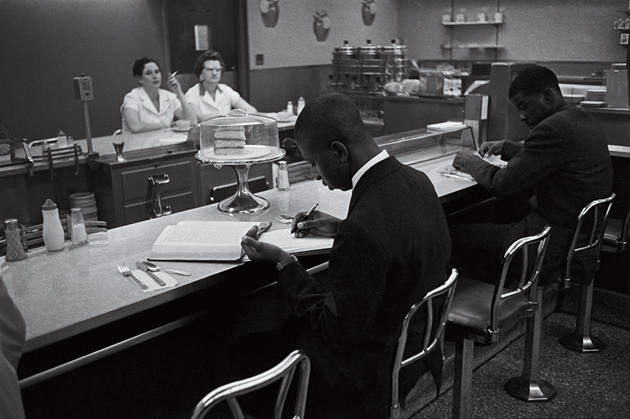
Students from Saint Augustine’s College study while participating in a sit-in at a lunch counter reserved for white customers in Raleigh, North Carolina, 1960 © Bettmann/CORBIS
Captured by television crews and photojournalists, images of brutality traveled across the country and around the globe, prompting many observers to demand a presidential response. On the evening of June 11, Kennedy delivered a nationally televised address in which he forthrightly condemned racial injustice. In explaining his decision to deploy the National Guard to enforce the court-ordered desegregation of the University of Alabama, Kennedy showed the ever-present influence of the Cold War on his thinking:
[W]hen Americans are sent to Vietnam or West Berlin, we do not ask for whites only. It ought to be possible, therefore, for American students of any color to attend any public institution they select without having to be backed up by troops.
The remedies Kennedy proposed addressed racial mistreatment in voting, education, and employment, all of which were volatile areas. The most controversial area he sought to address, however, was racial discrimination in privately owned places of public accommodation.
When Kennedy sent his civil rights bill to Congress, many observers supposed that it would either expire altogether or survive as mere decoration. In 1957 and 1960, Congress had enacted the first civil rights bills since Reconstruction, but only after Southern congressmen succeeded in extracting concessions that rendered the legislation ineffectual. There was also an important block of conservative Republicans who were largely indifferent to the plight of oppressed racial minorities and opposed the statutes out of a general antipathy toward federal regulation.
Four months after Kennedy outlined his civil rights bill, he was assassinated in Dallas. Within a few days, Lyndon Johnson delivered a speech to a joint session of Congress in which he invoked Kennedy’s martyrdom to heighten the emotional appeal of the legislation. Johnson’s Southern background, parliamentary experience, and personal ruthlessness made him a better shepherd than his predecessor.
The congressional proceedings included more than eighty days of debate and the longest group filibuster in Senate history. No African Americans sat in the Senate at the time, and only five were among the 435 who considered the bill in the House. The insistent voices of African Americans had made civil rights a congressional priority, but those voices emerged only intermittently in the hearings. Notably absent from the witness list was Martin Luther King Jr. (Other leading activists, including Roy Wilkins, executive secretary of the NAACP, did appear.)
Leading the charge for the administration was Attorney General Robert F. Kennedy, who argued that racial exclusion from places of public accommodation was so objectionable because it stigmatized all African Americans:
White people of whatever kind — prostitutes, narcotics pushers, Communists, or bank robbers — are welcome at establishments which will not admit certain of our federal judges, ambassadors, and countless members of our Armed Forces.
The bill’s opponents opted for rhetorical tactics that will be familiar from today’s political debates. When the legislation was first considered, in 1963, Mississippi governor Ross Barnett charged that “[m]inority groups . . . have taken to the streets . . . to blackmail this Congress,” and that the bill was part of a communist conspiracy “to divide and conquer our country from within.” Alabama governor George Wallace was similarly apocalyptic, denouncing the bill as “a long step in a socialistic scheme . . . which will bring the total destruction of private property rights.” Wallace insisted that “the free and uncontrolled use of private property is the basic and historic concept of Anglo-Saxon jurisprudence,” and that this concept, rather than racial discrimination per se, was the key issue at stake.
Proponents of the bill pointed to statutes compelling racial separation to impugn the good faith of segregationists who complained that antidiscrimination laws infringed on the personal autonomy of property owners. Where was the libertarianism of the segregationists when states dictated the color schemes of plates or the precise distance by which entrances to restaurants must be separated? When Senator Strom Thurmond of South Carolina complained that the proposed bill encroached on private parties’ right to use their property as they saw fit, Attorney General Kennedy shot back: “was that point raised when South Carolina . . . ruled that an establishment could not serve a Negro?”
Segregationists, in turn, charged racial liberals with hypocrisy. Liberals, Wallace claimed, had
invited the Negro to come North to a land of milk and honey. They have accepted the proposition, and instead of finding this utopia, they have found unemployment. They have been stacked in ghettos on top of one another, to become a part of every city’s Harlem.
Wallace had a point. Although racial mistreatment was most open, pervasive, and formalized in the South, it existed throughout the country; at least in the South, Wallace boasted, “the Negro knows where he can go. . . . We are not hypocritical about it.”
Segregationists also attacked the bill on judicial grounds, invoking the Supreme Court decision that had invalidated the public-accommodations provision of the Civil Rights Act of 1875. If it was unconstitutional for the government to tell private businesses whom they could and couldn’t serve in 1883, they argued, the same remained true in 1964. Instead of addressing this challenge head-on, the bill’s proponents, even as they acknowledged that political morality was the primary basis for their support, focused on the Constitution’s commerce clause (which gave Congress the power “to regulate Commerce . . . among the several States”) as the principal justification for the bill. The Supreme Court had offered no opinion on the commerce-clause justification in 1883, and had interpreted it broadly since upholding the New Deal legislation of the 1930s. Kennedy maintained that the inhibitions on travel imposed by segregation detrimentally affected interstate commerce. If, under the commerce clause, “Congress can, and does, control the service of oleomargarine in every restaurant in the nation,” he noted, “surely it can insure our nonwhite citizens access to those restaurants.”
Segregationists complained that the commerce-clause justification was a sham. Some racial liberals complained as well. One was Senator John Sherman Cooper of Kentucky:
I do not suppose that anyone would seriously contend that the administration is proposing legislation, or the Congress is considering legislation, because it has suddenly determined, after all these years, that segregation is a burden on inter-state commerce. We are considering legislation because we believe . . . that all citizens have an equal right to have access to goods, services, and facilities which are held out to be available for public use and patronage.
On July 2, 1964, after the Senate approved the civil rights bill, 73–27, and the House approved it 289–126, Johnson signed it into law. All persons, the new legislation declared, “shall be entitled to the full and equal enjoyment of . . . any place of public accommodation, as defined in this section, without discrimination.”
Title II of the act of 1964 was broad, proscribing discrimination on account of religion and national origin in addition to race and color (like its 1875 antecedent, it failed to say anything about gender), but its mode of enforcement was weak in comparison with the 1875 act and various analogous state statues; Title II allowed for remedy only through injunctive relief — a court order directing a defendant to stop violating the statute. Other laws had criminalized violations, making defendants liable to misdemeanor convictions carrying jail time of up to a year, and substantial fines and damages. Title II’s softer enforcement design was touted as a virtue by proponents who sought to accentuate the new bill’s moderation.
The debate over the Civil Rights Act has reverberated throughout the subsequent decades. Its rejection by Barry Goldwater, the Republican presidential candidate in 1964, played a major role in severing the historical tie between African Americans and the Party of Lincoln. Franklin Delano Roosevelt’s New Deal had attracted many black people to the Democratic Party, as had Harry S. Truman’s order in 1948 to desegregate the Armed Forces. But in the 1950s, African Americans still voted Republican in substantial numbers. In 1956, Dwight Eisenhower received 39 percent of the nonwhite vote. In 1960, Richard Nixon received 32 percent. By contrast, in 1964, Goldwater received only 6 percent. Since then no Republican candidate has received more than 18 percent.
Opposition to the act has had other haunting ramifications. The campaign to stop Robert Bork’s 1987 Senate confirmation for the Supreme Court drew particular energy from those who recalled with dread his condemnation of the public-accommodations provision of the Civil Rights Act back in the days when he was a professor at Yale Law School. The principle behind the legislation, Bork maintained,
is that if I find your behavior ugly by my standards . . . and if you prove stubborn about adopting my view of the situation, I am justified in having the state coerce you into more righteous paths. That is itself a principle of unsurpassed ugliness.
Bork conceded that the act sprang from a “justifiable abhorrence of racial discrimination,” and he bemoaned the fact that most of the law’s opponents were politicians who had previously defended segregation. In rejecting the act, Bork was probably acting as an authentic (rather than an opportunistic) libertarian.
The same may be true today of Kentucky senator Rand Paul, who has raised hackles with his civil-libertarian critique of antidiscrimination legislation. The difficulty is in distinguishing nonracist libertarianism from its fraudulent, pretextual lookalikes. There is good reason to be skeptical of those who, in the name of liberty, condemn a law that has rescued millions from the tyranny of unchecked racial ostracism.
The struggle for racial equality in access to public accommodations has been considerably more successful than struggles on other fronts. Title IV of the Civil Rights Act authorized the U.S. attorney general to initiate and intervene in public-school desegregation cases. But racial separateness in public primary and secondary schooling and inequality in access to education are still acute. Title VII bars racial discrimination in many employment markets and established the Equal Employment Opportunity Commission, but employment discrimination remains prevalent. The Civil Rights Act of 1968 and subsequent amendments have banned racial discrimination in a wide range of housing transactions. Yet such discrimination remains notoriously common.
In the aftermath of Title II’s passage, there was no analogue to the resistance that confronted school desegregation or the evasions that greeted the Voting Rights Act. No troops had to be called in to force hoteliers to open their establishments to black travelers. Although Title II had been the provision in the bill about which emotions ran highest, it rather quickly faded in prominence after enactment.
Why has the struggle against racism been more effective in public accommodations than in schooling, housing, employment, and the administration of criminal justice? The principal explanation is that Title II attacks a more vulnerable target. Proving racial discrimination in those other areas of social life can be difficult. Furthermore, by the 1960s, discrimination in public accommodations was already largely confined to the South, whereas many of the other issues addressed by the Civil Rights Act affected states north of the Mason–Dixon. Reforming race relations in public accommodations, moreover, did not appear to entail the same provocative redistribution of valuable opportunities that was feared elsewhere. The presence of black consumers in motels, theaters, restaurants, and the like is simply less threatening to many white people than black participation in other activities and venues — for instance, as managers at workplaces or representatives in legislatures. Unlike desegregation at the workplace, where the erosion of white privilege cost real jobs for white workers, the desegregation of public accommodations did not require from white people more than psychic sacrifices. The public-accommodations provisions gave many white businesspeople cover to do what market forces would have nudged them to do anyway, absent the emotional force of racial prejudice and the fear of retaliation by white bigots.
Perhaps for these reasons, there has long existed a tendency to underestimate the importance of the struggle against racial mistreatment in places of public accommodation. Minimizing the significance of the law he had opposed, a Mississippi restaurateur claimed defiantly in December 1964 that “desegregation of public accommodations does not basically alter the pattern of social life anywhere.” That is why, he asserted, “it has been accomplished as easily as it has.” Even supporters of the effort have tended to downplay it. “What is the value,” the civil rights activist Bayard Rustin once asked, “of winning access to public accommodations for those who lack money to use them?”
People lacking money one day, though, might have it another. And the struggle was not primarily about this or that individual being able to enjoy the consumer market. It was about historically oppressed racial groups being given equal respect. It was about the symbolism of inclusion.
“Symbolism” is often contrasted with and subordinated to “substance.” But symbolism can be of transcendent importance, and so it was in this instance, as reflected in the lengths to which opponents and proponents of the act were willing to go to deny or gain the power to be free of racial discrimination in places of public accommodation.
Many of the key accomplishments of the civil rights revolution were, of course, initially symbolic — invalidating segregation even in the few places where separate happens to be equal, elevating the meaning of “black,” or transforming the terms on which white and black people interact (no more demeaning references to “boy” or “girl” when addressing adult African Americans).
The Civil Rights Act and its entailments made a difference in my family’s trips to South Carolina. After 1964, my parents continued to feel burdened by the need for racial vigilance. White police officers still made my father distressingly nervous. But the signage of Jim Crow segregation rather quickly disappeared. Some places from which we had recently been barred became openly welcoming. White attendants and cashiers started calling my father “sir” and my mother “ma’am.” The Negro Motorist Green Book ceased publication. We continued to dine out of those lovingly packed coolers. But we began to shed the sense that we were traveling through enemy territory. My family started to feel that we, too, had a right to enjoy the freeway.

